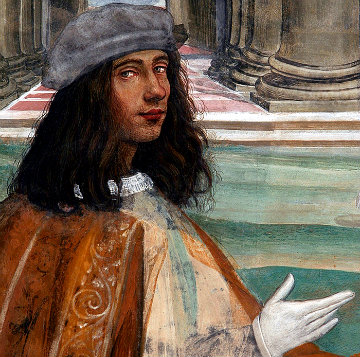| Sitemap | ||
|
|
Sodoma 'the sodomite' also known as Giovanni Antonio Bazzi 1477-1548 Italian High Renaissance Painter of the Sienese School Stylistically influenced by the following painters;Leonardo Da Vinci, Domenico Beccafumi, Pinturicchio, Veronese and Tintoretto Pupil of Leonardo Da VinciCause of Death - Old Age  Biography Sodoma was one of the most outstanding painters of the Renaissance era. The prevailing characteristic of his paintings are tortured expressions and intense contrasts of color. He was a man of unconventional habits and ideas, of tremendous resolve, extraordinary boldness, and huge appetites. Art historian, Vasari, revealed that the name 'Sodoma' stands for 'the sodomite' and asserted "His manner of life was licentious and dishonorable, and as he always boys and beardless youths about him of whom he was inordinately fond, this earned him the nickname of Sodoma" Being gay during the Classical Renaissance era was not as dangerous as it was in times past. Sodoma lived a rich and full live, receiving Vatican commissions and attening the best social events. He was accepted and valued for his amazing talent and wit. Sienna Senna had always been a center of art and learning. For hundreds of years artistic innovation and originality had been flowing from this beautiful town. Sodoma greatly benefited and contributed to the artistic legacy of Sienna. Historian and author, John C. Van Dyke, observed "Sienna, alive in the fourteenth century to all that was stirring in art, in the fifteenth century was in complete eclipse, no painters of consequence emanating from there or being established there. In the sixteenth century there was a revival of art because of a northern painter settling there and building up a new school. This painter was Sodoma (1477?-1549). He was one of the best pupils of Leonardo da Vinci, a master of the human figure, handling it with much grace and charm of expression, but not so successful with groups or studied compositions, wherein he was inclined to huddle and over-crowd space. He was afterward led off by the brilliant success of Raphael, and adopted something of that master's style. His best work was done in fresco, though he did some easel pictures that have darkened very much through time. He was a friend of Raphael, and his portrait appears beside Raphael's in the latter painter's celebrated School of Athens. The pupils and followers of the Siennese School were not men of great strength. Pacchiarotta (1474-1540?), Girolamo della Pacchia (1477-1535), Peruzzi (1481-1536), a half-Lombard half-Umbrian painter of ability, and Beccafumi (1486-1551) were the principal lights. The influence of the school was slight. The Classical Renaissance Sodoma lived durng one of the most exciting times in art history. Clive Bell, author and art historian asserts "The Classical Renaissance was a new reading of human life, and what it added to the emotional capital of Europe was a new sense of the excitingness of human affairs. If the men and women of the Renaissance were moved by Art and Nature, that was because in Art and Nature they saw their own reflections. The Classical Renaissance was not a re-birth but a re-discovery; and that superb mess of thought and observation, lust, rhetoric, and pedantry, that we call Renaissance literature, is its best and most characteristic monument. What it rediscovered were the ideas from the heights of which the ancients had gained a view of life. This view the Renaissance borrowed. By doing so it took the sting out of the spiritual death of the late Middle Ages. It showed men that they could manage very well without a soul. It made materialism tolerable by showing how much can be done with matter and intellect. That was its great feat. It taught men how to make the best of a bad job; it proved that by cultivating the senses and setting the intellect to brood over them it is easy to whip up an emotion of sorts. When men had lost sight of the spirit it covered the body with a garment of glamour." The church and wealthy patrons prized Sodoma's paintings for their feverish zealotry and spiritual exuberance. His subjects, like his predecessors, are all religious – the Virgin Mary, the Life of Christ, the Apostles, Angeles and the Life of Saint Sebastian. Key Descriptive Words and Phrases associated with the Renaissance Movement - rebirth, rediscovery of the classical world, publication of Della Pittura, a book about the laws of mathematical perspective for artists, sfumato, chiaroscuro, Savonarola, spiritually significant, illuminated manuscript, idealized biblical themes, scriptorium, illuminator, Age of Discovery, axonometric drawing, curiosity about the natural world, realistic use of colours and light, Bonfire of the Vanities, Old Testament stories, ethereal and foggy backgrounds, Gospel parables, The Black death, romanticized landscapes, Christian symbolism. Principle Painters of the High Renaissance 1450-1530
Andrea del Sarto Require more facts and information about the painter and the artists of the renaissance period? Poke around every nook and cranny of the known universe for information this subject. Search Here © HistoryofPainters.com If you like this page and wish to share it, you are welcome to link to it, with our thanks. If you feel you have worthwhile information you would like to contribute we would love to hear from you. We collect essential biographical information and artist quotes from folks all over the globe and appreciate your participation. When submitting please, if possible, site the source and provide English translation. email the editor
References Giorgio Vasari, The Lives of the Most Excellent Painters, Sculptors and Architects', published in 1550 Avery Miller and James Benson, The High Renaissance , published in 1902
|
|